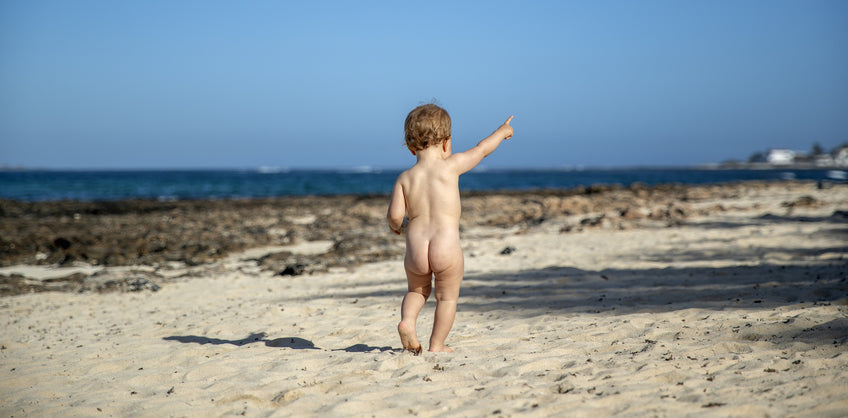If you're using diapers, diaper rash is likely something you have already had to deal with. But did you know there is more than one type of diaper rash, each with their own characteristics and ideal treatments? Read on to learn more about the different types of diaper rash and what you can do to treat them at home.
What Are The Different Types of Diaper Rash?
Seeing red, inflamed skin under your child’s diaper, the telltale sign of a diaper rash, can be a distressing sight. This irritated skin often causes discomfort and can be an unfortunate situation for both parent and child. One of the first steps in resolving the rash is figuring out what caused it. While many believe that all diaper rashes are the same, there are actually many baby diaper rash types caused by a variety of culprits.
IRRITANT / CONTACT DERMATITIS DIAPER RASH
An irritant/contact dermatitis diaper rash causes inflammation of the skin in the diaper area, and is caused by contact with substances like urine and fecal matter. A dermatitis rash usually produces red, shiny skin and typically does not impact the creases or folds of the skin. In addition to the buttocks, this rash can appear on the baby’s thighs, abdomen, or waist. Baby’s with sensitive skin are more prone to developing this kind of rash.
This rash can occur if a baby sits in a soiled diaper for a prolonged period of time, has diarrhea or frequent bowel movements, or is exposed to certain antibiotics directly, or through breastmilk. To soothe this rash, it’s best to allow the baby to go without a diaper for a while, use an organic diaper rash cream that contains zinc oxide, and opt for wipes that don’t contain alcohol or perfumes. You can also help prevent the rash from developing in the future by changing diapers more frequently, and rinsing baby’s bottom with warm water during the diaper change.
ALLERGIC DERMATITIS DIAPER RASH
A rash that produces spotty red skin, and sometimes peeling skin, is often caused by a diaper allergy. When this rash occurs almost exclusively under or around the baby’s diaper, it’s likely being caused by an ingredient in disposable diapers (like a dye), the detergent cloth diapers are washed in, or ingredients in baby wipes or creams commonly used in the diaper area.
To treat, an over-the-counter diaper rash cream can likely lessen the symptoms. You’ll also want to play detective by methodically trying a different brand of diapers, detergent, wipes, creams, and other substances that touch the skin under baby’s diaper, and seeing if any of the swaps help. It’s also wise to use products that are fragrance-free and hypoallergenic. If the rash seems severe, contact your baby’s pediatrician to see if prescription medication is required.
CANDIDA / YEAST DERMATITIS DIAPER RASH
A diaper rash caused by a yeast infection usually produces patches of deep red skin that also impact the folds and creases of the baby’s thighs. Red dots might also appear on the periphery of the primary rash. Girls might develop white or yellow vaginal discharge from this rash, and boys could experience scaling or redness on the penis.
This rash can be triggered by diarrhea, acid in stools, ammonia in urine, tight diapers, or ingredients in soaps and other products. It could also be a sign of gastrointestinal issues.
In many cases, a candida / yeast dermatitis diaper rash is treated with antifungal medication from the doctor. They can also make recommendations about how to add more probiotics into baby’s diet to help prevent this rash from developing in the future.
BACTERIAL DERMATITIS DIAPER RASH
Most commonly caused by group A Streptococcus and Staphylococcus aureus bacteria, a bacterial dermatitis diaper rash is one of the most serious out of the different types of diaper rash. When the rash is caused by strep, it’s typically bright red and centered around the anus. It might also lead to blood in baby’s poop. When the rash is caused by staph, there will likely be pus-filled bumps that have a red base.
This type of diaper rash is best treated by a pediatrician. It’s especially important to get treatment promptly if your baby develops a fever, or is excessively lethargic.
If you're still not sure what type of rash your child has, visit healthychildren.org for some helpful visuals that will help you narrow it down.
WHAT CAN BE DONE TO PREVENT DIAPER RASH?
There are a variety of things that can be done to prevent diaper rash. These prevention methods are focused on limiting the amount of irritants baby’s exposed to, nurturing the skin in the diaper area as much as possible, and ensuring baby’s diet isn’t the culprit causing the rashes.
-
Switch diaper brands. Because some diapers contain volatile organic compounds that could cause skin irritation, it’s best to switch to a diaper brand that’s hypoallergenic and antibacterial, and contains no harmful chemicals, like chlorine, phthalates, dioxin, alcohol, latex, or fragrances.
-
Use highly absorbent diapers. Diapers that are able to absorb a significant amount of moisture, like those from EcoPea, minimize the amount of moisture sitting on baby’s skin between diaper changes. Creating this dryer environment in baby’s diaper can help prevent the different types of diaper rash.
-
Purchase larger diapers. If your baby’s diapers are too tight, going to the next size up can prevent chafing that can lead to a rash. You also want to make sure you’re not putting the diaper on too tight – ideally, you should be able to fit two fingers into the waist of the diaper.
-
Use natural wipes. Just like diapers, some wipes contain ingredients that can cause a rash. Lower this risk by using wipes that are hypoallergenic and antibacterial, free of irritating chemicals and fragrances, and contain aloe.
-
Let baby’s skin breathe. Because many diaper rashes are caused, or exaggerated by, moisture sitting on the skin, you should let baby go diaper-free every now and then. During this time you can take baby outside if the weather is nice, or have them play on a waterproof mat that’s covered with a soft material.
-
Change diapers more frequently. Another effective way to prevent diaper rashes is to have shorter intervals between diaper changes. The longer baby sits in a wet diaper, the higher their chance of developing a diaper rash. You also want to be sure to carefully clean and dry their crevices so there’s no lingering urine or poop particles.
- Keep a food journal. As certain foods can cause diaper rashes, keep a record of any new foods you feed baby. For example, if you gave them pineapple for the first time on Monday and they develop a rash on Tuesday, but everything else they ate was part of their regular diet, the journal could help you deduce that pineapple is a likely cause of the rash.
If your baby is exclusively breastfed, keep track of changes in your diet, as certain foods that pass through the milk could create a rash.
WHAT CAN BE DONE TO SOOTHE DIAPER RASH?
In addition to an over-the-counter diaper rash cream, there are a number of natural substances that can soothe a diaper rash. Before applying these remedies, gently clean baby’s skin with warm water, then pat it dry. It’s also best to allow the substance to soak in for a few minutes before applying a new diaper.
-
Breastmilk. Putting a bit of breastmilk on the rash can work wonders, as breastmilk is filled with healing and antiseptic properties, and is a natural moisturizer and anti-inflammatory.
-
Coconut oil. This multi-purpose oil has anti-fungal and antimicrobial properties that can kill the Candida that causes some diaper rashes. It also reduces inflammation and increases hydration.
-
Apple cider vinegar, ACV. Diaper rashes caused by either fungal or yeast infection, can be treated with apple cider vinegar. The fermented liquid kills bacteria that agitates the rash, and prevents the growth of yeast. Mix one part ACV with three parts water before use.
-
Olive oil. Provide itch relief by treating the rash with olive oil, which has anti-inflammatory and antimicrobial properties.
- Honey and chamomile. Create an antiseptic spray by dissolving one teaspoon of honey into two cups chamomile tea, and transferring the mixture to a small spray bottle.
OTHER TYPES OF RASHES THAT MAY OCCUR
In addition to diaper rashes, your baby could develop a rash from eczema, psoriasis, seborrheic dermatitis, impetigo, and heat rash. These rashes are typically treated by ointment that your baby’s pediatrician, or a dermatologist, recommends or prescribes. Many care providers will also recommend using products that are fragrance-free and hypoallergenic, as often as possible. In the case of heat rash, the primary suggestion is usually cooling the affected area and letting the skin breathe.While a diaper rash can seem overwhelming, know that by utilizing the go-to treatment methods we listed, and taking steps to prevent more rashes from developing in the future, you’re doing everything you can to keep your baby safe and comfortable. And of course, if you’re ever in doubt, or fear your baby has a severe rash, don’t hesitate to call the pediatrician.



